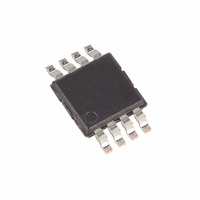DS1825U+ Maxim Integrated Products, DS1825U+ Datasheet - Page 4

DS1825U+
Manufacturer Part Number
DS1825U+
Description
IC THERMOMETER DIGITAL 8-USOP
Manufacturer
Maxim Integrated Products
Datasheet
1.DS1825U.pdf
(21 pages)
Specifications of DS1825U+
Function
Thermometer, Thermostat
Topology
Register Bank, Scratchpad
Sensor Type
Internal
Sensing Temperature
-55°C ~ 125°C
Output Type
Digital
Output Alarm
Yes
Output Fan
No
Voltage - Supply
3 V ~ 3.7 V
Operating Temperature
-55°C ~ 125°C
Mounting Type
Surface Mount
Package / Case
8-MSOP, Micro8™, 8-uMAX, 8-uSOP,
Temperature Threshold
Programmable
Full Temp Accuracy
+/- 0.5 C
Digital Output - Bus Interface
1-Wire
Digital Output - Number Of Bits
9 bit to 12 bit
Supply Voltage (max)
3.7 V
Supply Voltage (min)
3 V
Maximum Operating Temperature
+ 125 C
Minimum Operating Temperature
- 55 C
Supply Current
1.5 mA
Ic Output Type
Digital
Sensing Accuracy Range
± 0.5°C
Supply Voltage Range
3V To 3.7V
Resolution (bits)
12bit
Sensor Case Style
µSOP
No. Of Pins
8
Accuracy %
0.5°C
Rohs Compliant
Yes
Lead Free Status / RoHS Status
Lead free / RoHS Compliant
OVERVIEW
Figure 1 shows a block diagram of the DS1825, and pin descriptions are given in Table 1. The 64-bit ROM stores
the device’s unique serial code. The scratchpad memory contains the 2-byte temperature register that stores the
digital output from the temperature sensor. In addition, the scratchpad provides access to the 1-byte upper and
lower alarm trigger registers (T
user to set the resolution of the temperature-to-digital conversion to 9, 10, 11, or 12 bits. It is also used for the hard-
wired address programmed by the AD0-AD3 pins. The T
they will retain data when the device is powered down.
The DS1825 uses Dallas’ exclusive 1-Wire bus protocol that implements bus communication using one control
signal. The control line requires a weak pullup resistor since all devices are linked to the bus through a 3-state or
open-drain port (the DQ pin in the case of the DS1825). In this bus system, the microprocessor (the master device)
identifies and addresses devices on the bus using each device’s unique 64-bit code. Because each device has a
unique code, the number of devices that can be addressed on one bus is virtually unlimited. The 1-Wire bus
protocol, including detailed explanations of the commands and “time slots,” is covered in the 1-Wire BUS SYSTEM
section of this data sheet.
Another feature of the DS1825 is the ability to operate without an external power supply. Power is instead supplied
through the 1-Wire pullup resistor through the DQ pin when the bus is high. The high bus signal also charges an
internal capacitor (C
power from the 1-Wire bus is referred to as “parasite power.” As an alternative, the DS1825 can also be powered
by an external supply on V
Figure 1. DS1825 BLOCK DIAGRAM
4.7k
GND
V
V
DQ
DD
PULLUP
PP
), which then supplies power to the device when the bus is low. This method of deriving
DD
.
H
and T
Cpp
Parasite
Power
Circuit
Supply
Power
Sense
L
), and the 1-byte configuration register. The configuration register allows the
64-Bit ROM
1-wire Port
4 of 21
And
H
, T
L
, and configuration registers are NV (EEPROM), so
Control Logic
Memory
C
R
C
D
S
A
T
P
A
8-bit T
8-bit Config. Reg
16-bit Temp Reg
8-bit T
8-bit CRC Gen
AD0-AD3
Address Pin
Input Latch
H
L
Register
Register











